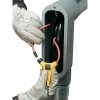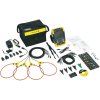What are sub-meters?
They find their use in various areas of the economy, whether in real estate services (for example, determining the power consumption of individual stores in the shopping centre), production (measuring electricity consumption in certain parts of the technological process), or also in many other industries.
In combination with modern applications, they find their way to users in the form of IoT applications, where they can provide invaluable data, often live, in a clear visual form.Directly on the phone or on a computer monitor, with no need for complex readings and measurements.
Sub-meterings are not subject to the metrological requirements for calibration and measurement accuracy reporting. On the one hand, this enables their significantly cheaper production and deployment in much larger numbers than with conventional electricity meters, and thus we get higher data granularity. On the other hand, it can lead to inaccuracies in the measurement, and thus also to a distortion of the real measured values and their erroneous evaluation.
The first test meeting took place in the laboratory. The second testing took place in real installed systems.
1. Laboratory measurement
A PTE (Portable Test Equipment) device was used for the measurement - it is a portable current and voltage source combined with a reference standard of accuracy class 0.02%.
Installation of devices and measurement
The sensor is connected to the PTE device using the current terminals and voltage cables.
Using PTE, precisely defined currents and voltages were generated, which we also compared with the values measured by the sensor.
Since the sensor used was not equipped with a metrological LED indicator of the measured power, the measured values were read directly from the application.
These values were then compared with the values generated on the PTE device and the measurement error was calculated.
The resulting error ranged from -3.2% to +2.6%, which corresponded to the initial assumptions.
2. Measurement in field
The second measurement was performed on installed devices at different clients in order to ensure better evaluation of the meters accuracy in real conditions. A reference standard with an accuracy of 0.05%, Working Standard WS2320A, was used for the measurement.
Current clamps or FCP (Flexible Current Probe) from AppliedPrecision were used for measuring the magnitude of the current, depending on the conditions of the specific installation. It is a flexible current sensor based on the principle of a Rogowski coil. You can also use the Fluke i2500 for separate current measurement.
Installation of devices with current clamps and connection with FCP
The measurement was performed by the same method as in the previous measurement, i.e. by direct comparison of the values measured by WS and by means of the MeriTO application.
Subsequently, other measured parameters that could affect the measurement accuracy were analyzed using software for WS.
Measurement 1.
Given the relatively stable curve of currents and voltages in individual phases, the results of this measurement were consistent and corresponded to the laboratory measured values.
Measurement 2.
This measurement was affected by a large distortion of the second phase, due to which the measured values were very inconsistent, even though the resulting measurement error was also in the range measured in the laboratory.
AppliedPrecision used their Portable Test Equipment and Working Standard. products for measurement. If you are interested in network analyzers, you can also check the other ones, e.g. from Fluke.
Conclusion
Two test days showed the importance of checking the accuracy of meters used in IoT-based applications. At the same time, however, it should be noted that two test days are a very short time to definitively determine the properties of individual meters. Improving accuracy is a continuous development process.
Laboratory measurements have confirmed the importance of calibrating the sub-meters by their manufacturers or system integrators. For calibration it is necessary to use standards with the accuracy higher at least by order of one magnitude in comparison with the assumed accuracy of sub-meters. From the point of view of the user of sub-meters or IoT solutions based on them, we need to work with the same measurement accuracy as the specified meters (electricity meters) used for invoicing have, so that the comparison of sub-measurement and billing measurement is relevant.
Field measurements showed greater demands on the measurement of various transients (switching on/off of appliances, greater distortions), the resistance of the meters to possible electromagnetic interference. This also implies the need for sufficient testing of IoT solutions, whether during their production or periodically at the place of their application.
If you are interested in the topic and would like to know more, feel free to reach out to us at sales@soselectronic.com.













